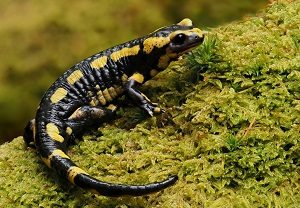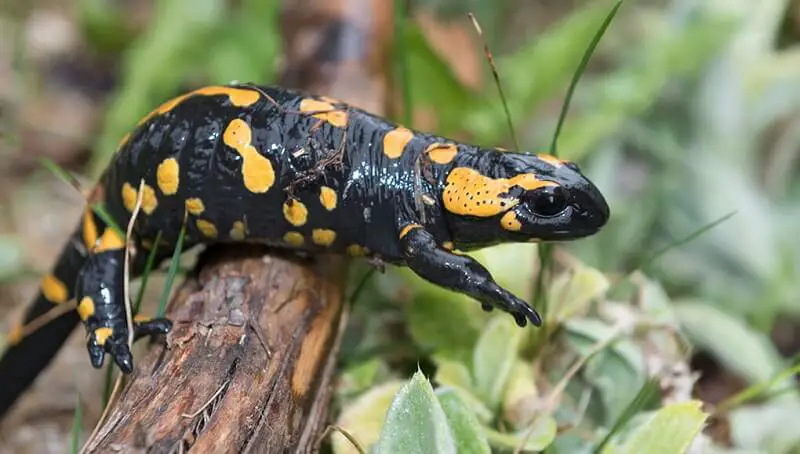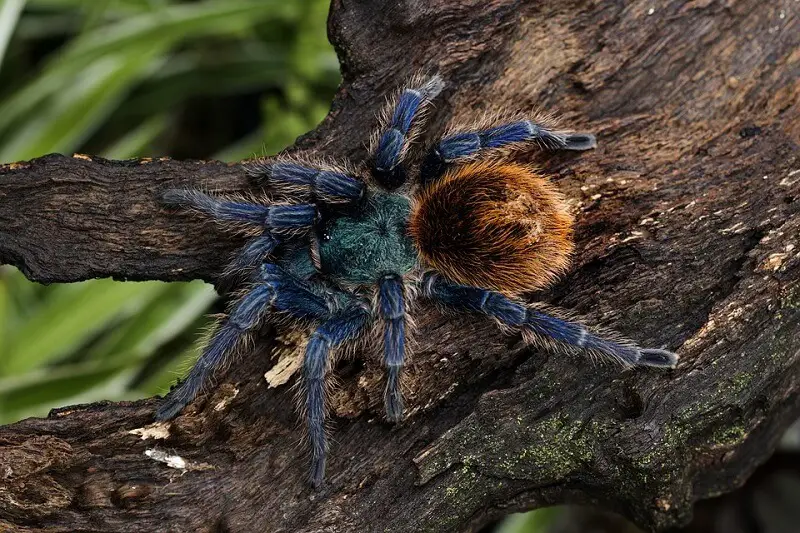The fire salamander is a poisonous species, which is confirmed by its living coloring on the upper body and which warns predators to stay away. Behind the eyes, there are glands secreting toxic substances that are not supported by any living creature who would dare to eat this salamander.
Origin
The fire salamander, Salamandra Salamandra, is part of the Amphibia Class, the order of Urodela, Caudate, the family Salamandridae, and the genus Salamandra.
Fire salamanders are native to Central and South Europe. There are many subspecies that can be found especially in countries such as Germany, Hungary, and Poland.
But from where does the name of Fire Salamandra come? In the past, it was thought that these animals had a connection to fire. Their skin secretes a kind of mucus that covers their entire body surface, protecting them and giving them the ability to pass through fire without burning.
What does a Fire Salamander eat?
The diet is mainly represented by insects, spiders, earthworms, and snails, but the reptile occasionally eats tritons or tadpoles. Salamanders feed mainly in the evening, the species being nocturnal, but also after rain, when the ground is moist.
How can you recognize a Fire Salamander?
It has a body length of 18-28 cm and a black-glossy color with yellow asymmetrical spots. Some specimens have a yellow base shade with black spots of different sizes. There are fire salamanders in which the yellow color is red or orange. In this species, the female is larger than the male and weighs more.
You might also like my articles with interesting facts on black mambas, frill-necked lizards, or red-footed tortoises.
The male has the forelegs and hind legs longer than the female, probably because they use them to hold her during mating. The head is large, strongly flattened on the top, the muzzle rounded, and the eyes are large, prominent, and have a black iris. The tail is short and thick, and its coloring is similar to that of the body.
This Salamander has strong limbs, prominent parotoid glands, and a cylindrical tail that is shorter than the body. They can reach dimensions between 20-30 cm. Females are much larger than males. These salamanders have a warning color, usually black with yellow or orange spots of various shapes and sizes.
Where can you find a fire salamander?
Fire salamanders live in Europe and are more common in hill and mountain areas, at altitudes between 100 and 1000 m, in the area of deciduous forests. They prefer deciduous forests because they like to hide under the fallen leaves, on the ground, there finding the necessary humidity.
It is known as the common salamander and is distributed in the wooded hill and mountain regions of Europe, North-West Africa, and South-West Asia. They are found in a great number in Italy, Germany, Hungary, France, Bulgaria, Austria, Belgium, and Spain. In some areas, you can find it at altitudes of up to 2000 m.
Fire salamanders prefer shady, cool, and moist places. During the day they stay hidden in the fallen leaves, under wood or stones, wherever they find the right environment. They are active in the evening and at night, but on rainy days they are active during the day.
Behavior
Salamanders have a shy, calm temperament, but if they feel attacked, they can eliminate a toxin through the skin. They prefer to run and can be quite fast despite their heavy appearance and slow movements. They will only eliminate the toxin if they have to. Avoid handling them and wash your hands thoroughly if you touch them.
Salamanders actively defend themselves against predators. The species is able to secrete toxins from glands under the skin called parotoid glands. Toxins are represented by neurotoxic alkaloids called samandarin.
These alkaloids cause high blood pressure, muscle contractions, convulsions, and hyperventilation in all vertebrates. The glands are concentrated in certain areas of the body, especially on the head area and yellow spots on the body.
Reproduction
 Males and females look similar except for the mating season, then the difference is more obvious because in males there is a swelling in the cloacal area. Mating takes place during spring-summer and the eggs will be deposited in the spring of the following year in the water.
Males and females look similar except for the mating season, then the difference is more obvious because in males there is a swelling in the cloacal area. Mating takes place during spring-summer and the eggs will be deposited in the spring of the following year in the water.
After the female is courted and accepts mating, the male deposits the spermatophore, a gelatinous capsule containing substance. This capsule is designed to protect them against dehydration.
After that, the female absorbs the capsule from the male into the cloak and the 20-30 eggs are fertilized internally. When they are ready to hatch, the female deposits the wrapped larvae into a thin, transparent membrane in a place with clear water. Immediately after deposition, the membrane breaks down in the water, and the larvae can swim freely.
At the time of hatching, the larvae are about two centimeters long and have external gills. A few months after the deposit, at a size of 5-6 cm, they lose their gills and metamorphose, becoming terrestrial, like their parents.
In some subspecies, larvae continue to develop in the female’s abdomen until she gives birth to fully developed metamorphs. Fire salamanders reach sexual maturity at age 3-4, with females usually maturing a year later than males.
The fire salamander is not an endangered species. Life expectancy in captivity is 50 years, while in the wild about 20 years.
Facts
It is an animal that produces toxins.
It is recommended to wash your hands after touching a fire salamander.
The fire salamander accumulates a greater amount of poison in the skin before the hibernation period.
For many centuries, the fire salamander has been a faithful companion of alchemists and wizards. Amphibians were dried, crushed, and added to all kinds of medicinal potions and poisons to improve their effectiveness.




